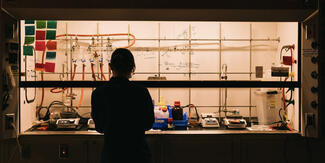
The science of light
Researchers in the field of photonics are harnessing the power of light to improve our electronics, help us live more sustainably, and learn more about how our bodies work.
Photonics research by several faculty is highlighted in 'The science of light,’ a recent feature article by the School of Engineering.
Most of us don’t spend much time thinking about light, beyond whether or not we can see what we’re doing. But to researchers in the field of photonics, light is a tool that does much more than simply illuminate our world. Photonics is the science and technology of controlling light – manipulating its behavior with precise crystalline structures, encoding information in its wavelengths, using it to trigger chemical reactions, or applying any other number of techniques. Photonics researchers are putting light to work to improve our electronics, help us live more sustainably, and provide a better understanding of our health and well-being.
"One of the great things about light is that it’s ubiquitous, it’s everywhere; we know how to generate it; we know how to harness it. And as we continue to develop finer and finer control over these things, light becomes an enormously powerful tool." - Prof. Dan Congreve
Featured faculty are Dan Congreve, Jennifer Dionne (Materials Science and Engineering), Shanhui Fan, Miriam B. Goodman (Molecular & Cellular Physiology), David Miller, H. Tom Soh, Olav Solgaard, and Jelena Vuckovic.
- Read full article, Stanford Engineering, "The science of light"